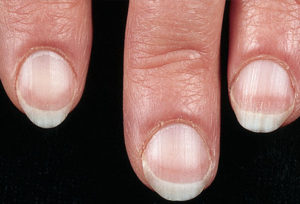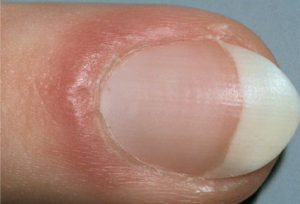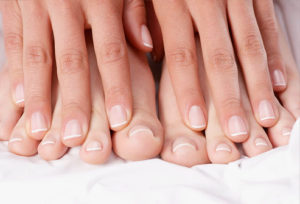Diagnosis of disease by nails
Did you know your nails can reveal clues to your overall health? A touch of white here, a rosy tinge there, or some rippling or bumps may be a sign of disease in the body. Problems in the liver, lungs, and heart can show up in your nails. Keep reading to learn what secrets your nails might reveal.

Pale Nails
Very pale nails can sometimes be a sign of serious illness, such as:
- Anemia
- Congestive heart failure
- Liver disease
- Malnutrition

White Nails
If the nails are mostly white with darker rims, this can indicate liver problems, such as hepatitis. In this image, you can see the fingers are also jaundiced, another sign of liver trouble.

Yellow Nails
One of the most common causes of yellow nails is a fungal infection. As the infection worsens, the nail bed may retract, and nails may thicken and crumble. In rare cases, yellow nails can indicate a more serious condition such as severe thyroid disease, lung disease, diabetes or psoriasis.

Bluish Nails
Nails with a bluish tint can mean the body isn’t getting enough oxygen. This could indicate a lung problem, such as emphysema. Some heart problems can be associated with bluish nails.

Rippled Nails
If the nail surface is rippled or pitted, this may be an early sign of psoriasis or inflammatory arthritis. Discoloration of the nail is common; the skin under the nail can seem reddish-brown.

Cracked or Split Nails
Dry, brittle nails that frequently cracked or split have been linked to thyroid disease. Cracking or splitting combined with a yellowish hue is more likely due to a fungal infection.

Puffy Nail Fold
If the skin around the nail appears red and puffy, this is known as inflammation of the nail fold. It may be the result of lupus or another connective tissue disorder. Infection can also cause redness and inflammation of the nail fold.

Dark Lines Beneath the Nail
Dark lines beneath the nail should be investigated as soon as possible. They are sometimes caused by melanoma, the most dangerous type of skin cancer.

Gnawed Nails
Biting your nails may be nothing more than an old habit, but in some cases it’s a sign of persistent anxiety that could benefit from treatment. Nail biting or picking has also been linked to obsessive-compulsive disorder. If you can’t stop, it’s worth discussing with your doctor.

Fungal infections of nails
Diseases of the nails can cause significant social, psychological, and physical damage to an affected individual. These disorders may be isolated to the nail unit itself or be part of a larger systemic disease that may present first, or only, in the nail unit. The images different types of fungal infections.


Spoon-shaped nails
Koilonychia is a condition characterized by spoon-shaped, concave nails (shown). Causes of koilonychia include iron deficiency, diabetes mellitus, protein deficiency (especially in sulfur-containing amino acids), SLE, exposure to petroleum-based solvents, trauma, and Raynaud disease.

Temporary cessation of nail
Beau lines (arrow) are transverse depressions in the nail plate caused by temporary cessation of nail growth. Its causes include intermittent doses of immunosuppressive therapy or chemotherapy, nail injury, cold temperatures, and illness. Severe zinc deficiency has also been proposed as a cause of Beau lines.

Longitudinal striations
Onychorrhexis, or the presence of longitudinal striations or ridges on the nail plate, can simply be a sign of advanced age, but it may also be associated with conditions such as rheumatoid arthritis, peripheral vascular disease, lichen planus, and Darier disease (broad white and red striations in the nails). A central vertical ridge or groove may be due to myxoid cysts (shown) that appear near the nail fold; myxoid cysts are associated with osteoarthritis.

Transverse white lines
Any acute illness can produce transverse white lines, also known as Mees lines. In addition, they might be caused by heavy metal toxicity (classically associated with arsenic poisoning), chemotherapy, carbon monoxide poisoning, Hodgkin disease, malaria, or leprosy. The timing of the causative event or disease process may be determined from the location of the lines on the nails.

Nails Are Only Part of the Puzzle
Though nail changes accompany many conditions, these changes are rarely the first sign and many nail abnormalities are harmless — not everyone with white nails has hepatitis. If you’re concerned about the appearance of your nails, see a dermatologist.

References:
http://www.parsiteb.com
reference.medscape
webmd
 Parsi Teb Physical and Mental Health Journal
Parsi Teb Physical and Mental Health Journal 



